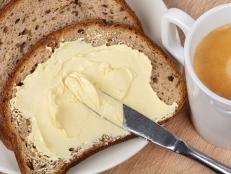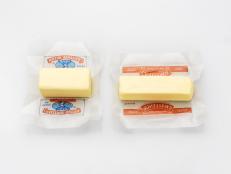The Do’s and Don’ts of Making Almond Butter and Almond Milk from Scratch
We’re cracking the code on this nut-based food group.

Get a Premium Subscription to the Food Network Kitchen App
Download Food Network Kitchen to sign up and get access to live and on-demand cooking classes, in-app grocery ordering, meal planning, an organized place to save all your recipes and much more.
Whether you hopped on the trend years ago or it’s a rather new discovery for you, there’s no doubt that nut butter and nut milk are everywhere these days. Though you can easily buy both nut butters and nut milks at your local grocery store or from your favorite online retailer, making each from scratch is a great way to see the entire nut-to-table process in real time. It’s also a lot easier than you might think. Food Network Kitchen chef Dana Beninati recently walked fans through all the Do's and Dont's of Homemade Almond Butter and Almond Milk. Here’s everything we learned — in a nutshell.
There's a Big Difference Between Roasted and Raw Almonds
If you don’t have all that much experience cooking with — or eating almonds — it might surprise you to know that roasted almonds and raw almonds aren’t interchangeable. In fact, not only are roasted almonds darker in color than raw almonds, they smell completely different too. “If you mix them up in your pantry and you’re not really sure which is which — when I smell these, I barely smell much of anything,” Dana says about her bowl of raw almonds.
When it comes to her bowl of roasted almonds, however, Dana shares that it is their “super fragrant floral notes” that’ll aid you in identifying them correctly. “They smell like what they are,” she says of their nutty aroma.
Believe it or not, it’s this potency in smell that makes roasted almonds better for making nut butters, while the subtly of raw almonds (or any other raw nut for that matter) makes them best for making nut milks.
Soaking Your Almonds Is a Must When Making Nut Milk
The very first step for transforming your raw almonds into almond milk might seem simple —you’re just soaking them in water after all — but it’s super important, too. Not only does this step make your almonds softer, which in turn makes them easier to pulse in a blender, it also causes your almonds to release an enzyme which aids your body with digestion. “You might have tried alternative milks because you struggle to digest traditional dairy milk, so this soaking stage is a good thing,” Dana advises.
Though eight hours of soaking is the ultimate goal, Dana also notes that a shorter amount of time is acceptable too. “I’ve done it only soaking them for two hours and it works … the flavor just isn’t as potent because you can’t grind them as finely,” she notes.
Get Yourself a Nut Milk Bag
Though you can easily drink your freshly made almond milk directly after blending it, you’ll probably notice pieces of almond skin and other sediment floating around inside. If you prefer your milk to have a smoother texture, running it through a fine mesh sieve or nut milk bag is the way to go. “What this is going to do is catch all of that sediment. You want to do it in batches,” Dana advises while vigorously squeezing her freshly blended milk through her nut milk bag.
Nut milk bags are also super environmentally-friendly since you can easily wash them and reuse them again and again. You can also add the almond sediment that’s leftover in your nut milk bag into various dishes to give them greater depth and pack them full of fiber. “Almonds are little powerhouses of nutrients, so I sometimes add this in if I’m making peanut butter cookies or almond butter cookies to give them more body,” Dana shares while showing off her leftover almonds. She also adds, “If you’re concerned about getting enough fiber, you can add that into smoothies. I’ve added it into curries once … so don’t get rid of it.”
Sweeten vs. Unsweetened: It’s Up to You!
If you’ve purchased almond or other alternative milks before, you’ve probably noticed that they come in both sweetened and unsweetened varieties. Though this step is completely up to you and your own specific tastes, there are some ingredients you’ll want to avoid if you’re aiming on adding a little touch of sweetness to your homemade nut milk. “What I wouldn’t recommend is adding straight sugar because it won’t dissolve,” Dana advises. She then goes on to add that monk fruit extract, vanilla extract, honey, pure maple syrup, pureed prunes or date syrup are all great choices, and that about one or two teaspoons of each goes a really long way.
With almond butter, on the other hand, it’s okay to use brown sugar or granulated sugar as a sweetener since both will easily dissolve as you pulse your nuts in the food processor.
The Freezer Is Your Friend for Storing Nuts of All Kinds
Storing your nuts in preparation for your nut butter or nut milk making is more important than you might think. “Do not store any of your nuts, if you can avoid it, in your pantry,” Dana shares while answering a viewer question on the topic.
“The best place for any of these guys is actually in your freezer. All of them — I want you to think of them like little packets of oil. It’s the oil that carries the flavor. Oil goes bad really quickly, so if you keep it in a nice, dark, ice cold place like the freezer or the fridge, your nuts or your nut butters will last a lot longer,” Dana adds.
Oil is Key When Making Nut Butter
Unlike other varieties of nut butter, which can be pretty solid, almond butter often has an oilier texture. Though it may look strange when you see a layer of it sitting at the very top of your almond butter jar, it’s this oil that keeps your almond butter adequately moist and makes it easier to spread. When making almond butter from scratch, Dana notes that you can use nearly any oil of your choosing, except olive oil: “I love this because I have full control over the amount of oil I’m putting into my nut butter, and what kind of oil it is. Vegetable oil, canola oil, avocado oil, any of those will work perfectly here. Avoid oil olive — too fragrant."
Ask Yourself Some Questions Before Storing Your Nut Butter
This probably seems self-explanatory, but you’ll want to pour your almond milk in an airtight container and place it in the refrigerator right after making it, so that’s it’s nice and cold when you go to add it into your coffee, cereal, smoothies etc.
For your almond butter, however, where you store it completely depends on how quickly you think you’ll eat it. “With nut butter, it’s not necessarily the same rules,” Dana shares when answering a view question on the subject. Because your almond butter is bound to have an ample amount of oil in it, keeping it in a cooler, darker place like your refrigerator is best.
However, if you’re not sure how quickly you’ll go through your almond butter, there’s nothing wrong with keeping it in the pantry, either. “I go through it pretty quickly, so I’ll leave it in the pantry,” Dana shares. “In the pantry, it lasts easily a month or two. In the fridge, double that time, so you’re looking at two to three months.”
Related Links:

































